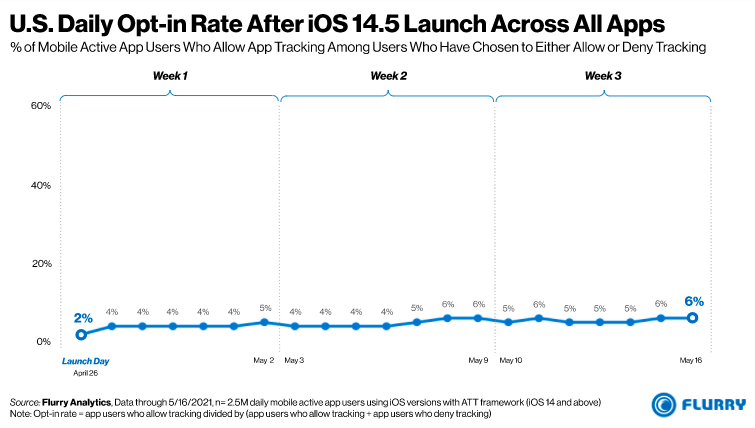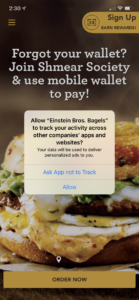The Cookieless World: What You Need to Know About Google and Apple’s Latest Privacy Updates

Generic, one-size-fits all service and experience simply won’t cut it for modern consumers. In fact, according to Salesforce’s State of the Connected Customer report, over half of customers expect offers to always be personalized.
In order to deliver personalized, relevant experiences to customers, brands must have access to the right data. But while it’s clear consumers want tailored experiences, many are also wary about how their data is being used. The same Salesforce report found that 61% of consumers feel they’ve lost control over how their personal information is used. And 86% want more transparency over how their information is used.
Businesses must adapt to meet consumers’ changing expectations for data privacy — while continuing to deliver relevant information and experiences. And Google and Apple are taking the lead on preserving consumer privacy.
Read on for an overview of Google and Apple’s recent privacy updates — and how these policies will impact brands looking to make authentic connections with consumers.
Google is Moving Toward the Goal of a Cookie-Free Chrome
Last year, Google made waves by announcing its goal of eliminating third-party cookies on Chrome by 2022. It is worth noting that other browsers, including Safari and Firefox already block third-party cookies by default.
Google’s plan is to replace cookies with “viable privacy-first alternatives” developed via its Privacy Sandbox initiative. One viable methodology developed by the Privacy Sandbox is the Federated Learning of Cohorts — or FLoC for short.
Rather than tracking an individual via a cookie, FLoC involves tracking user behavior across the internet — and then grouping these users into audiences (or cohorts). Brands can serve up ads to these groups, but there’s no way to distinguish an individual within the cohort. Essentially, that means users will still get relevant ads tailored to their interests and behavior — but their anonymity is preserved.
While it won’t be possible to identify individual users, it’s not all doom and gloom for brands. According to a blog from Google, FLoC has the potential to deliver results for brands that are “nearly as effective as cookie-based approaches.”
Apple is Prioritizing User Privacy with iOS 14.5 and App Tracking Transparency (ATT)
Mobile privacy is a growing concern for many consumers. Per McKinsey & Company, 67% of consumers feel it’s at least somewhat important to them that the apps and programs they use are only accessible to whom they authorize. Apple is making moves to ensure this privacy is preserved.
Developers with apps on the Apple App Store had access to tools that allowed them to track user data within the app. That data can then be paired with similar behavioral data from around the web to identify information about a specific user. Then, advertisers can serve up highly targeted advertisements to individual users, based on their interests and behaviors.
Apple device users have always had the ability to block tracking in an app. But opting out was something a user had to be proactive about, as it was an option hidden within the phone’s settings. As a result, many users were opted in to be tracked by default, perhaps without even realizing it.
But that all changed when Apple rolled out iOS 14.5 and App Tracking Transparency (ATT).
Today, apps must explicitly ask before tracking users. If an app wants to track a user and share that information with third parties (such as advertisers), a prompt appears on the user’s screen to ask for permission. The app developer can add a short description explaining why users should allow the app to track them.
For example, this prompt for the Neutrogena Skin360 app lets users know their data will be used to “provide a more personalized ad experience.” And this prompt from the Einstein Bros. Bagels app lets the user know their data will be used to “deliver personalized ads.”
If the user clicks “Allow,” nothing changes. The app can continue to track the user as they have in the past.
But if the user selects “Ask App not to Track,” the app can no longer monitor and store data from the user.
Understandably, many advertisers are concerned that consumers will opt out in droves. After all, the choice is one or the other; there’s no in-between.
And it seems these concerns are well-founded. A Forbes article projected that about 40% of users would opt in to being tracked when prompted. But data from Flurry shows that in the first three weeks after the release of iOS 14.5, no more than 6% of users opted in to being tracked.

Apple isn’t leaving app developers high and dry, though. They offer other options, including the SKAdNetwork, which allows a company to determine how many times its app was installed after an ad was displayed, and Private Click Measurement, which lets brands know how many times users clicked on a product ad within an app. But these methods don’t allow brands to access information about a specific user.
Brands Must Adapt to Effectively Connect with Customers
Apple and Google have been applauded for their moves to protect user data. But there’s no denying that these updates will present challenges to brands looking to deliver personalized, relevant ads and experiences. The methods they’ve come to depend on to connect with customers may no longer be effective.
So, what’s a marketer to do?
Last week at Salesforce Connections 2021, there were some great sessions on this very topic. In one session, Martin Kihn, SVP of Strategy at Salesforce, spoke about the future of data and privacy in a cookieless future.
In a cookieless world, it’s still very much possible to make connections with customers and deliver personalized, relevant experiences. But brands must change their approach.
Martin’s recommendation to brands is to focus on gaining more first-party data — in other words, the data a brand collects itself. He says it’ll be key for most brands, specifically those using the Salesforce Marketing Cloud.
Martin explained that Salesforce’s research has found that in general, consumers don’t mind sharing their data with brands. But they’ve got to be able to change their minds and opt-out in the future. Consumers also need to understand what they’re getting in exchange for sharing their data.
And according to Martin, data attracts more data. For example, if a user visits a website for the first time, they get a generic experience. But the more information the user provides (and the more they purchase), the more personalized and engaging their site experience is. Because the customer loves the personalized experience, they’re more willing to share data to get it. Over time, brands can develop valuable, mutually beneficial relationships with their customers leveraging first-party data — even in a cookieless world.
Innovative Tools to Help Prioritize First-Party Data
Brands must also tap into innovative tools to identify new ways to engage with customers, deliver tailored experiences, and build lasting relationships. This can help brands build more first-party data.
For example, Google Business Messages can be an effective way for brands to connect with and delight customers, especially at a time when the majority of consumers prefer engaging with brands via private messaging channels, rather than traditional channels. Social channels like Facebook and Instagram also have messaging tools for brands.
And while these tools do not directly address a marketer’s cookie problem, they do allow for more opportunities to collect first-party data. Whether through a bot or a live person, chat tools provide an opportunity to send prospects a form to request a quote, trial or other download that would facilitate targeted marketing.
1440 is honed in on its mission to save brands time, and as these changes take place, we will have the tools to make managing messages on various platforms easy by bringing them into Salesforce.
Learn more about Messaging Studio by 1440 — coming soon!
Brands must adapt to connect with customers and deliver great experiences in a cookieless world. Those that successfully collect and leverage first-party data from their customers and use innovative tools to engage shoppers will be well-equipped to deliver personalized experiences their customers love.

